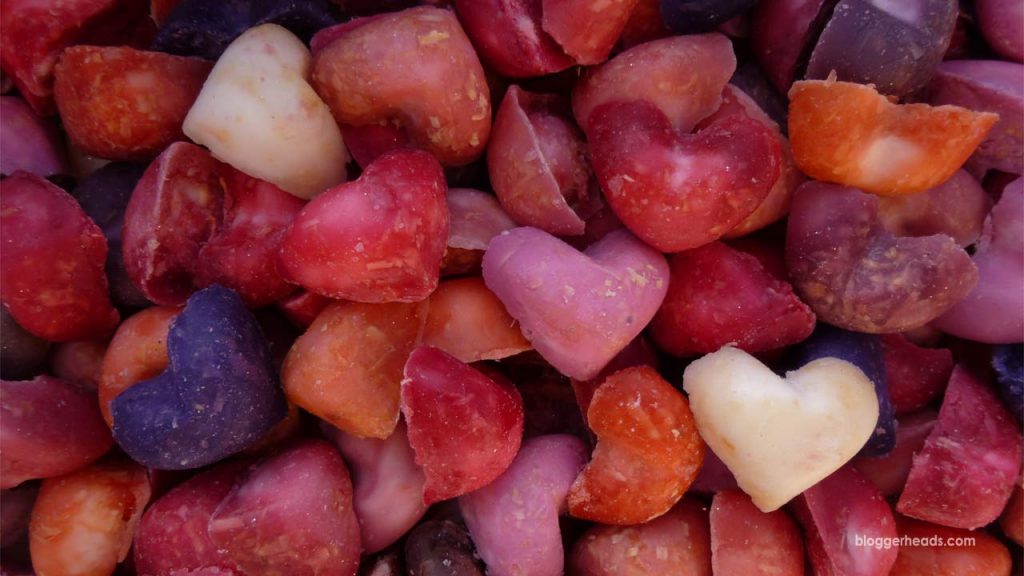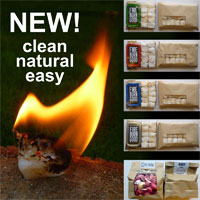This entry was posted on
Wednesday, February 27th, 2019 at
11:08 am and is filed
under Scouting.
I’ve been doing a lot of work on teaching fire over the last few years, and over time I’ve developed what I think is a vast improvement on current homemade firelighting technology.
I’m sure you’ve seen cotton balls and make-up remover pads dipped in wax before, maybe even witnessed a few egg cartons being subjected to a hot pour, but once you learn this wax firelighter recipe using cotton balls, wood chips and silicone moulds you will never go back.
I have a lot more to share and have started a Patreon account to fund further episodes, but thought I would kick off by putting this previously-secret recipe in as many hands as possible. It’s not only useful for camping enthusiasts and survivalists; these firelighters are great for starting barbecues and fireplaces at home, and making them is a fun and educational activity for young people (just make sure you invest in some drop sheets and aprons first).
Everything you need is in the video, but I’ve published the full transcript below for reference.
Have fun.. and please support my Patreon!
TRANSCRIPT
Hello. My name is Tim Ireland. I’m a Scout leader and keeper of the secrets of fire. What you are about to see is a shortcut developed by an expert; it is no substitute for expertise. Always be cautious with fire.
This a wax-based firelighter I developed with a soft core of cotton wool and wood chips. It’s cheap and easy to make, it’s stable, clean and water-resistant, and you can light it with a spark.
Today I’m going to show you how to make hundreds of these from a single candle and a few household materials.
First, put some tough cardboard down for spills.
For this batch we’ll be using a single 500g paraffin wax candle, and some waste from the previous batch.
You’ll also need some wood shavings from the pets section, and some balls of cotton wool in either large or small sizes.
For small lighters use small cotton balls and silicone ice cube or confectionary trays with small shapes. Stars are fun, hearts are great, but square shapes are easier to pack in a tin and I have multiple trays, which makes the process faster.
For large lighters use large cotton balls and silicone ice cube or confectionary trays with large shapes. These would let you make hearts, spooky ghost faces, magical unicorns, or a whole bunch of upvotes.
Throw a handful of wood shavings into about half a bag of cotton balls, and shake the whole business until you have a bunch of furry little Ferrero Rochers.
Now you’ll need two hotplates, and two stainless-steel saucepans, ideally with metal handles.
Finally, you will need a working tray, a dipping cup (mine is aluminium) a thick handled spoon, a thin handled spoon and a stainless steel teapot with integrated filter.
Medium for melting, low for cooling, cup for dipping, teapot for filtering, thick-handled metal spoon for when you want to bring the temperature of your wax down by stirring it. Thin spoon for when you don’t.
If you must use gas hobs, you will need a heat-diffusing ‘simmer ring’, and they look like this.
Now – let’s melt some wax.
My hobs go up to 6, ‘low’ is set to a little under 1 and ‘medium’ goes no higher than 3.
In goes the candle… and the waste from the last batch.
We do not hurry melting the wax. Slowly and gently does it. If vapour is coming off your pot, you are coming in too hot. Pull up.
Pour the melted wax into the metal teapot. Then gently strain it into the low-heat saucepan, before leaving it to cool for a bit.
When ready, pour your near-viscous wax into the dipping cup.
Then, stir occasionally until you hit the sweet spot, when wax sticks to your spoon. Results vary with perfume and pigments, but generally viscosity kicks in just under 60 degrees Celsius, by which time you will see a skin on top of the wax.
Now you dip each cotton ball in turn – 3 times each, then press it into the silicone mould and pinch or wipe the top gently; the wax will start to solidify in your fingers as you finish the tops off, so everything important happens in this moment.
Note I’m using gloves. You can use ordinary washing up gloves if you like. The wax isn’t all that hot, but if you’re going to be doing this hundreds of times you will want to avoid nerve damage to your digits, because like you, they need to feel things.
I’m going to do a short set of ‘waterproof’ lighters here. It uses mostly the same method, but while the wax is still malleable, you fold the waste into the middle from the edge and press and wipe to finish the top and edges.
This is more time-consuming and the resulting lighters are harder to crack open in their finished state, but they are waterproof when done and it’s faster than double-dipping them, which is the alternative path to waterproofing.
Me, I prefer an unfinished and merely water-resistant top because the lighters are easier to break open and start that way.
In a moment we’re going to zoom in and get in a little closer to the action to show how easy it is. The wax forms a seal around the cotton before you’re in for the second dip, meaning the cotton remains soft and wispy on the inside, even while you press it into the mould, so there’s no need to be gentle. Dip-dip-dip shove, pinch, Dip-dip-dip shove, pinch. It’s quite relaxing when you get into a rhythm.
Wait for each tray to cool and then turn over and push them out like you would ice cubes.
Then trim with scissors.
Pour any off-cuts into your waste pile for the next batch.
From that 500 gram candle and some waste, I’ve produced 108 firelighters weighing a total of 470 grams… and some waste.
That’s enough to fill my tobacco-sized tin a dozen times over, all from one candle.
To use the lighters, you just break open the top, pull some of the cotton out and throw a spark into the wispy threads. The wood shavings help to take that reaction to the wax, creating a chain reaction specifically designed to make the pyrolysis process as efficient as possible: from here the cotton heart turns into a wick, drawing the fuel into the reaction, until every last scrap is gone.
Watch the wax around the firelighter as it burns. It doesn’t melt or drip. With the exception of a few minerals and some stray carbon in the smoke, all of the solid matter in the lighter is transformed by heat into gas, generating more heat and continually feeding the reaction until all you are left with is a ball of what used to be cotton that is now an aerated fluff of coal that’s eager to oxidise and still giving off heat.
Heat, of course, is the heart and start of your fire. Flames are just showing off.
So, that’s my firelighter recipe. It’s one of my secrets, but teaching you about fire and its secrets is going to take a little extra effort.
I’ve finally started a Patreon account, and my first intended project is a series of videos teaching the secrets of fire, starting with pyrolysis and the advantage of knowing what’s happening at a molecular level, and what’s powering that at an atomic level.
It sounds complicated, but I can assure it is far easier than diving right in and rubbing two sticks together… and you can help to bring these lessons to life.
Mastery of fire is not only a useful skill, it is a deeply rewarding pursuit with therapeutic properties and even social rewards that pre-date civilisation.
The first time you turn a spark into a flame and your heart goes ‘woof!’, you’ll begin to understand. I’d like to teach you, and I figure we can also make and use some nifty tools and some downright gorgeous firelighters along the way.

On that note what you should do right after you subscribe is leave a note in comments saying if you would like to see hearts, ghosts, unicorns, or upvotes in the next video.
Thanks for your time. Please support my Patreon, and I hope to see you in the next episode.
Cheers all.
END TRANSCRIPT
(Music: ‘Featherlight‘ by Lee Rosevere under a Creative Commons license)



